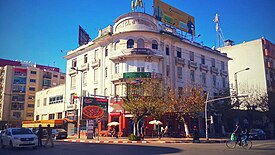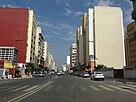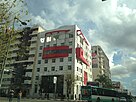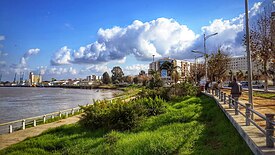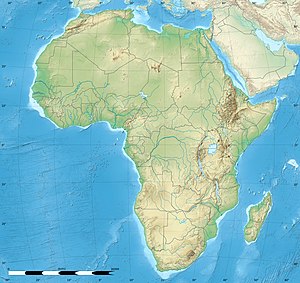Kenitra(Arabic:القُنَيْطَرَة,al-qunayṭara,[alqunajtˤira],lit. 'the little bridge'[2]) is acityin northwesternMorocco.It is aporton theSebou Riverwith a population of 431,282 as of 2014.[3]It is one of the three main cities of theRabat-Salé-Kénitraregion and the capital of the similarly namedKénitra Province.During theCold War,theUS Naval Air Station Port Lyauteyserved as a stopping point inNorth Africa.
Kenitra
القنيطرة | |
|---|---|
Avenue Mohamed Diouri, Avenue Mohamed V, Kenitra | |
| Coordinates:34°15′N6°35′W/ 34.250°N 6.583°W | |
| Country | |
| Region | Rabat-Salé-Kénitra |
| Province | Kenitra |
| Founded | 1681 |
| Area | |
• Total | 112 km2(43 sq mi) |
| Elevation | 26 m (85 ft) |
| Population (2014)[1] | |
• Total | 431,282 |
| • Rank | 9th in Morocco |
| Time zone | UTC+1(CET) |
| Website | http://www.kenitra.ma/ar/ |
History
editAncient history
editThe history of the city begins with the foundation of a trading post byCarthaginianexplorerHanno.It was known back then asThamusida.[4]
Colonial and recent history
editIn March 1912 the French government and the Sultan of Morocco,Abd al-Hafid,signed theTreaty of Fez.Because of his growing unpopularity, the Sultan asked the French government for protection against the Berber rebel tribes surrounding Fez. France appointedHubert Lyauteyresident-general in Morocco.
General Lyautey restored peace and order to the country after crushing the tribal uprising. After safely moving the Sultan from Fez to the current capital city, Rabat, Lyautey began his task of civilian administration.
One of the first preoccupations of General Lyautey was to build ports along the inhabitable Atlantic coast where there were no natural harbors. He established Port Lyautey in 1912 as aFrenchmilitaryfortand town. Its port, at the mouth of the Sebou river, was opened in 1913.[5]It soon became the best river port in Morocco.[6]Kenitra draws its name from aculvertbuilt at Fouarat lake upstream of the kasbah. This culvert was destroyed in 1928. In 1933, the French officially named the locale "Port Lyautey".
It was renamed "Quneitra" in 1956 as Morocco gained its independence. The city has grown rapidly to be a shipping centre for agricultural produce (mainly fruit), fish, timber, and lead and zinc ores. The city's industrial area lies upstream of the port.
U.S. Naval Base
editIn November 1942, afterOperation Torch,the Americans captured the Port LyauteyFrenchfighter base as a military base, namedCraw Field.For three months the 21st Engineer Aviation Regiment worked on the airfield. In February 1943 theSeabeesof the 120th Naval Construction Battalion took over all construction activities.[7]The Navy ran the base until 1947, when the State Department negotiated reversion of control to France. In 1950, a $23,000,000 expansion was authorized, but then theKorean Wardiverted resources. In the 1950s, nearly 10,000 people were on the base making it the largest aggregation of Americans in any one overseas base outside Japan. Later, the base in Kenitra was expanded to become aU.S. Naval Air Station.[8]
The base was shared by both the US and Morocco through theCold War.A small Navy communications out-station in Sidi Yahia closed in the late 1970s. The Air Station was closed in 1991.
Climate
editKenitra has ahot-summer Mediterranean climate(Köppen climate classificationCsa). In summer, there are 27.4 days on average in which the maximum daily temperature is at 30.0 °C (86.0 °F) or higher, and 1.6 days with max temperature above 40.0 °C (104.0 °F). Winters are mild and rainy, with sub-freezing temperatures occurring only 0.3 days per year on average.[9]The highest recorded temperature was 47.7 °C (117.9 °F) on 1 August 2003, and the coldest was −3.0 °C (26.6 °F) on 13 February 2012.[9]
| Climate data for Kenitra (normals and extremes 1991–2020, sun 1981-2010, rainy days 1961-1990) | |||||||||||||
|---|---|---|---|---|---|---|---|---|---|---|---|---|---|
| Month | Jan | Feb | Mar | Apr | May | Jun | Jul | Aug | Sep | Oct | Nov | Dec | Year |
| Record high °C (°F) | 24.8 (76.6) |
32.2 (90.0) |
35.1 (95.2) |
36.5 (97.7) |
43.7 (110.7) |
46.3 (115.3) |
46.1 (115.0) |
47.7 (117.9) |
44.6 (112.3) |
39.9 (103.8) |
33.5 (92.3) |
26.0 (78.8) |
47.7 (117.9) |
| Mean daily maximum °C (°F) | 17.9 (64.2) |
18.8 (65.8) |
20.8 (69.4) |
22.1 (71.8) |
24.8 (76.6) |
26.6 (79.9) |
28.2 (82.8) |
28.7 (83.7) |
27.6 (81.7) |
25.5 (77.9) |
21.6 (70.9) |
19.0 (66.2) |
23.5 (74.2) |
| Daily mean °C (°F) | 12.5 (54.5) |
13.5 (56.3) |
15.5 (59.9) |
17.0 (62.6) |
19.6 (67.3) |
22.0 (71.6) |
23.7 (74.7) |
24.2 (75.6) |
22.7 (72.9) |
20.4 (68.7) |
16.3 (61.3) |
13.8 (56.8) |
18.4 (65.2) |
| Mean daily minimum °C (°F) | 7.0 (44.6) |
8.1 (46.6) |
10.1 (50.2) |
11.8 (53.2) |
14.5 (58.1) |
17.4 (63.3) |
19.2 (66.6) |
19.6 (67.3) |
17.8 (64.0) |
15.2 (59.4) |
11.0 (51.8) |
8.6 (47.5) |
13.4 (56.1) |
| Record low °C (°F) | −1.0 (30.2) |
−3.0 (26.6) |
1.0 (33.8) |
1.7 (35.1) |
6.6 (43.9) |
10.5 (50.9) |
12.8 (55.0) |
2.2 (36.0) |
1.7 (35.1) |
2.1 (35.8) |
1.7 (35.1) |
−0.5 (31.1) |
−3.0 (26.6) |
| Averageprecipitationmm (inches) | 87.4 (3.44) |
59.6 (2.35) |
52.4 (2.06) |
41.4 (1.63) |
17.3 (0.68) |
3.7 (0.15) |
0.2 (0.01) |
0.6 (0.02) |
21.9 (0.86) |
57.1 (2.25) |
104.9 (4.13) |
93.0 (3.66) |
539.5 (21.24) |
| Average precipitation days(≥ 1 mm) | 7.8 | 6.5 | 6.7 | 5.2 | 2.8 | 0.9 | 0.1 | 0.2 | 1.9 | 5.4 | 7.2 | 7.9 | 52.6 |
| Average rainy days | 12.3 | 12.7 | 12.2 | 11 | 7.6 | 2.9 | 0.3 | 0.7 | 2.8 | 8.6 | 13.3 | 14 | 98.4 |
| Mean monthlysunshine hours | 182.4 | 184.4 | 235.6 | 268.2 | 313.7 | 316.6 | 333.2 | 315.6 | 264.6 | 230.4 | 190.3 | 170.7 | 3,005.7 |
| Source 1:NOAA[9](sun 1981-2010)[10] | |||||||||||||
| Source 2: NOAA (days with rain 1961–1990)[11] | |||||||||||||
| Climate data for Kenitra (1991-2020)[9] | |||||||||||||
|---|---|---|---|---|---|---|---|---|---|---|---|---|---|
| Month | Jan | Feb | Mar | Apr | May | Jun | Jul | Aug | Sep | Oct | Nov | Dec | Year |
| Mean number of days withthunder | 1.9 | 1.4 | 2.0 | 1.6 | 1.3 | 0.5 | 0.7 | 0.4 | 1.1 | 1.4 | 2.2 | 1.9 | 16.4 |
| Number of days with wind speed > 10 m/s (36 km/h) | 9.6 | 10.5 | 16.7 | 20.7 | 24.4 | 24.1 | 22.5 | 21.8 | 20.3 | 14.2 | 10.3 | 9.7 | 204.8 |
Population
edit| 1982 | 1994 | 2004 | 2010 | 2014 |
|---|---|---|---|---|
| 187,000 | 291,000 | 358,000 | 400,000 | 430,000 |
Areas and neighbourhoods
edit- Mdina
- Khabazate
- The Cigogne
- La cite
- Modern city
- Mimosa
- La Ville Haute
- Popular districts
- Saknia
- Ouled Oujih
- Maghrib al Arabi
- Residential districts
- Bir Rami
- Ismailia
- Val fleuri
Education
editColleges and universities
edit- Université Ibn-Tofail(UIT)[13]
- ENCG Kénitra (École nationale de commerce et de gestion de Kénitra)
- HECI Kénitra (Hautes Etudes Commerciales et Informatiques)
- ENSA Kénitra (École nationale des sciences appliquées de Kénitra)
- ENSC Kénitra ([École nationale supérieure de chimie de Kénitra]
Transportation
edit- TheNational Route 1and theA1 motorwaypass through Kenitra and connect it toRabat-Saléin the south-west and toLarachein the north-east.
- The city is served by onerailway station:Kenitra-Ville.A shuttletrain,TNR, connects the city, every 30 minutes, toRabatandCasablanca.
- Ahigh-speed railline toTangierwas completed in 2018.[14](SeeKenitra–Tangier high-speed rail line.)
Sports
editKenitra Athletic Club, KAC
editIn 1938, a group of Kenitra natives created KAC.
This group of soccer lovers wanted to resist French domination in sports in Morocco.
The team, made entirely of Kenitra natives, succeeded in reaching the premier Moroccan soccer league in 1956. In 1960, KAC won its first championship league of Morocco. KAC embarked in a journey of glories by winning the 1973-81-82 championship leagues and the 1961 throne cup.
Ahmed Souiriwas a long-time manager and coach. KAC has produced many international players.
Noureddine BouyahyaouiandLabid Khalifawere among the players who helped the Moroccan national soccer team qualify for the second round of the World Cup finals in Mexico in 1986. Mohammed Boussati still holds a national record of goals by scoring 25 goals in one soccer championship season in 1981–82.
Its home is theKenitra Municipal Stadiumwhich has a capacity of 15,000 people.[15]
Basketball
editThe KAC Kénitra was a very successful basketball team during the 70s and 80s.
Natives from Kenitra
editKenitra was the birthplace of:
- Amina Aït Hammou,Olympic athlete
- David Bitan,Israeli politician
- Ismaël Ferroukhi- Director and scriptwriter
- Karl Stephan- American artist and educator
- Margie Cox,American R&B Singer
- Mohamed Sijelmassi,writer and physician
- Nayef Aguerd– Moroccan footballer
- Saïd Aouita,Olympic athlete
- Sofian Chakla– Moroccan footballer
- Tariq Chihab- Former international footballer
- Youssef Chippo,International football player
- Zouhair Laaroubi- Moroccan footballer
See also
editNotes and references
edit- ^"POPULATION LÉGALE DES RÉGIONS, PROVINCES, PRÉFECTURES, MUNICIPALITÉS, ARRONDISSEMENTS ET COMMUNES DU ROYAUME D'APRÈS LES RÉSULTATS DU RGPH 2014"(in Arabic and French). High Commission for Planning, Morocco. 8 April 2015.Retrieved29 September2017.
- ^Team, Almaany."ترجمة و معنى قنيطرة بالإنجليزي في قاموس المعاني. قاموس عربي انجليزي مصطلحات صفحة 1".www.almaany.com.Retrieved2021-07-16.
- ^"Population légale d'après les résultats du RGPH 2014 sur le Bulletin officiel N° 6354".hcp.ma(in Arabic). Archived fromthe originalon 2018-12-26.Retrieved2015-07-11.
- ^"Hanno | Phoenician, Mediterranean, Navigator | Britannica".www.britannica.com.Retrieved2024-03-10.
- ^Kénitra depuis 1912Archived2003-10-03 at theWayback Machine(in French)
- ^In Moroccoby Edith Wharton, New York: Charles Scribner's Sons 1920
- ^Port Lyautey, Chapter XX, The Mediterranean Area, Building the Navy's Bases in World War II, History of the Bureau of Yards and Docks and the Civil Engineer Corp, 1940-1946, Volume II, UNITED STATES GOVERNMENT PRINTING OFFICE, WASHINGTON, p. 80[1]
- ^"History of Port Lyautey".Archived fromthe originalon 2011-07-15.Retrieved2006-12-31.
- ^abcd"World Meteorological Organization Climate Normals for 1991-2020: Kenitra-60120"(CSV).ncei.noaa.gov(Excel).National Centers for Environmental Information.Retrieved22 April2024.
- ^"World Meteorological Organization Climate Normals for 1981–2010".National Centers for Environmental Information.Archived fromthe originalon 11 November 2021.Retrieved10 November2021.
- ^"Kenitra Climate Normals 1961–1990".National Oceanic and Atmospheric Administration.RetrievedMarch 16,2015.
- ^"Kenitra, Morocco Metro Area Population 1950-2020 – macrotrends.com".macrotrends.com.
- ^"Univesité Ibn Tofail – Univesité Ibn Tofail".6 February 2006. Archived from the original on 6 February 2006.
{{cite web}}:CS1 maint: bot: original URL status unknown (link) - ^"'Africa's fastest train' steams ahead in Morocco ".
- ^"Stade Municipal de Kénitra – StadiumDB.com".stadiumdb.com.
